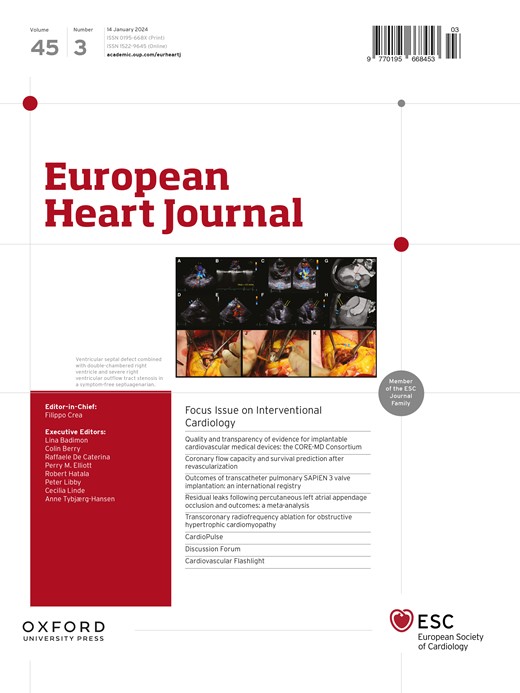左心室几何、脑结构和认知:一项观察性研究。
IF 35.6
1区 医学
Q1 CARDIAC & CARDIOVASCULAR SYSTEMS
引用次数: 0
摘要
背景和aims心血管(CV)疾病和痴呆具有共同的危险因素,并且在老年人中经常共存。理解简历-大脑的相互作用对于解决他们相互关联的负担至关重要。这项研究调查了CV表型、大脑结构和认知之间的联系。方法对15519名无神经退行性疾病或卒中的UK Biobank参与者(中位年龄64岁,49%为女性)进行分析。验证性因子分析将18个CV磁共振成像(MRI)生物标志物汇总为左心室收缩功能(gSyst)、舒张功能(gDiast)和几何(gGeom)的潜在变量;动脉顺应性采用主动脉扩张率(AoD)测定。多变量线性回归模型评估了与脑MRI表型的关联,包括灰质体积、白质高密度、MRI弥散白质微观结构和海马体积。模型根据年龄、体重指数、身高、平均血压和心血管危险因素进行调整。探索性中介模型评估了海马体积是否与CV表型和认知之间的关联。结果ggeom与海马体积的相关性最强,反映了更大的心肌质量、壁厚和心室体积[β = 0.082 (0.048 ~ 0.117);β = 0.039(0.006-0.071)[男性],是唯一与更好的认知相关的CV表型,包括更高的流体智力和更快的反应时间。海马体体积显著地说明了geom与认知之间的正相关关系。相比之下,gSyst、gDiast和AoD与大脑结构的关联较弱且不一致,与认知无关。结论:脑室几何形状是与大脑结构和认知最密切相关的CV表型。海马体体积可能有助于解释这种关联,但需要进一步的研究来调查因果关系。本文章由计算机程序翻译,如有差异,请以英文原文为准。
Left ventricular geometry, brain architecture, and cognition: an observational study.
BACKGROUND AND AIMS
Cardiovascular (CV) diseases and dementia share common risk factors and often coexist in older adults. Understanding the CV-brain interaction is essential for tackling their interconnected burden. This study investigated the link between CV phenotypes, brain architecture, and cognition.
METHODS
Overall, 15 519 UK Biobank participants without neurodegenerative diseases or stroke (median age 64 years, 49% female) were analysed. Confirmatory factor analysis aggregated 18 CV magnetic resonance imaging (MRI) biomarkers into latent variables for left ventricular systolic function (gSyst), diastolic (gDiast) function, and geometry (gGeom); arterial compliance was measured by aortic distensibility (AoD). Multivariable linear regression models evaluated associations with brain MRI phenotypes, including grey matter volume, white matter hyperintensities, MRI diffusion white matter microstructure, and hippocampal volume. Models were adjusted for age, body mass index, height, mean blood pressure, and CV risk factors. Exploratory mediation models evaluated whether hippocampal volume accounted for associations between CV phenotypes and cognition.
RESULTS
gGeom, reflecting greater myocardial mass, wall thickness, and ventricular volumes, showed the strongest association with hippocampal volume [β = 0.082 (0.048-0.117) in females; β = 0.039 (0.006-0.071) in males] and was the only CV phenotype associated with better cognition, including higher fluid intelligence and faster reaction time. Hippocampal volume significantly accounted for the positive relationship between gGeom and cognition across sexes. In contrast, gSyst, gDiast, and AoD demonstrated weaker and less consistent associations with brain structure and were unrelated to cognition.
CONCLUSIONS
Ventricular geometry emerged as the CV phenotype most strongly associated with brain architecture and cognition. Hippocampal volume may help explain this association, but further studies are needed to investigate causality.
求助全文
通过发布文献求助,成功后即可免费获取论文全文。
去求助
来源期刊

European Heart Journal
医学-心血管系统
CiteScore
39.30
自引率
6.90%
发文量
3942
审稿时长
1 months
期刊介绍:
The European Heart Journal is a renowned international journal that focuses on cardiovascular medicine. It is published weekly and is the official journal of the European Society of Cardiology. This peer-reviewed journal is committed to publishing high-quality clinical and scientific material pertaining to all aspects of cardiovascular medicine. It covers a diverse range of topics including research findings, technical evaluations, and reviews. Moreover, the journal serves as a platform for the exchange of information and discussions on various aspects of cardiovascular medicine, including educational matters.
In addition to original papers on cardiovascular medicine and surgery, the European Heart Journal also presents reviews, clinical perspectives, ESC Guidelines, and editorial articles that highlight recent advancements in cardiology. Additionally, the journal actively encourages readers to share their thoughts and opinions through correspondence.
 求助内容:
求助内容: 应助结果提醒方式:
应助结果提醒方式:


